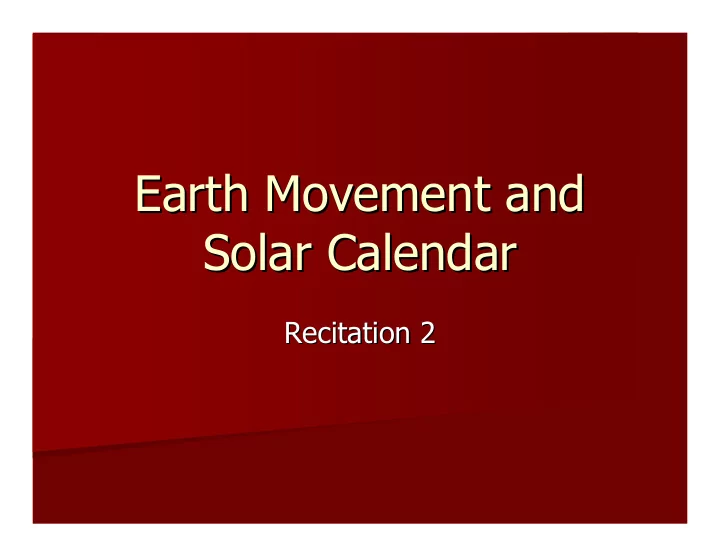

Earth Movement and Earth Movement and Solar Calendar Solar Calendar Recitation 2 Recitation 2
Elliptical Orbits Elliptical Orbits The planets move along elliptical orbits around the sun. This results in both a variation in the distance from the sun, and variation in the rotational velocity of each planet.
The earth is closest to the sun at the perihelion, furthest from the sun at the aphelion (the eccentricity of the orbit is exaggerated above for easy visualization)
Tilt Tilt The earth’s rotational axis is tilted from normal (right angle) to its orbital plane by roughly 23.5º. The tilt causes direct sunlight to fall on different parts of the earth of the course of a year.
Sunlight on tilted Earth Sunlight on tilted Earth Tilt is responsible for the seasons. As the tilted earth moves around the sun, direct sunlight moves north from the equator at the vernal equinox, to 23.5º north latitude at the summer solstice, back to the equator at the autumnal equinox, and south 23.5º south latitude at the winter solstice.
Sunlight on tilted Earth Sunlight on tilted Earth
Polar Coordinates Polar Coordinates Parallels – small circles & equator Latitude – arc angle from equator Meridians – great circles Longitude – arc angle from prime
Important Latitudes Important Latitudes Please note: 23.5 o is the same as 23 o 30’
Apparent Solar Day Apparent Solar Day The length of a day depends on what you’re watching. The time between seeing the sun appear at its highest point in the sky is longer than the time between seeing a star appear at its highest point in the sky. The sun is much closer than any other star, as such One rotation = 86,164 s the earth has to rotate Mean solar day = 86,400 s a little further to bring it back to the same place in the sky.
Orbit Effect Orbit Effect The elliptical nature of the earth’s orbit means that the time between sightings of the sun overhead is shorter in early April and later in October. If their were no tilt to the earth, the sun would always shine directly on the equator, and the distribution of times between the sun passing its highest point in the sky would look like the graph above.
Tilt Effect Tilt Effect Tilt is also affects the time between sightings of the sun at local noon. If the earth moved around the sun in a circular orbit (not elliptical), the time between the sun’s appearance at its highest point in the sky would look like this graph.
Orbit and Tilt Variation 20 15 Late (Minutes) Early 10 5 0 -5 -10 -15 -20 21- 20- 19- 21- 20- 20- 19- 19- 18- 17- 17- 16- 16- Dec Jan Feb Mar Apr May Jun Jul Aug Sep Oct Nov Dec However, earth is rotating at a tilt and moving along and elliptical orbit. The net effect of both motions produces the above distribution of times between local noon events.
Photographing the sun or marking the location of a sunbeam on the floor of a room with a skylight every 24 hours over the course of a year results in a shape known as the analemma. The analemma was an important navigational tool in the pre-GPS world, and was commonly included on maps of the time. It is still useful in areas such as architecture, solar energy engineering, landscaping, photography, and outdoor graphic design.
Recommend
More recommend